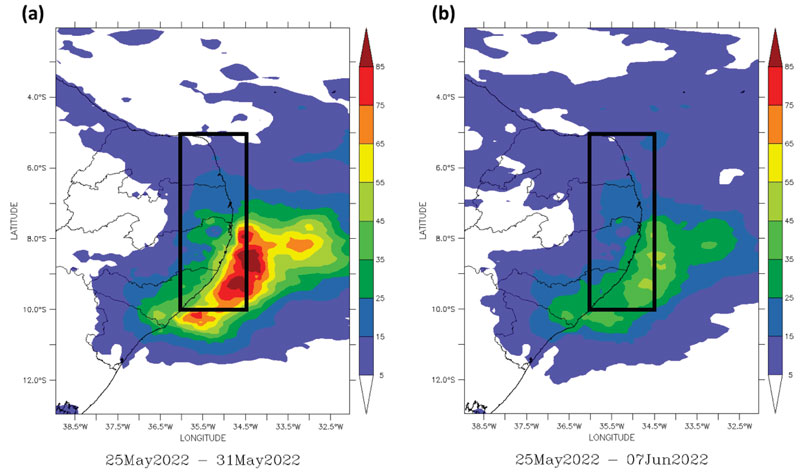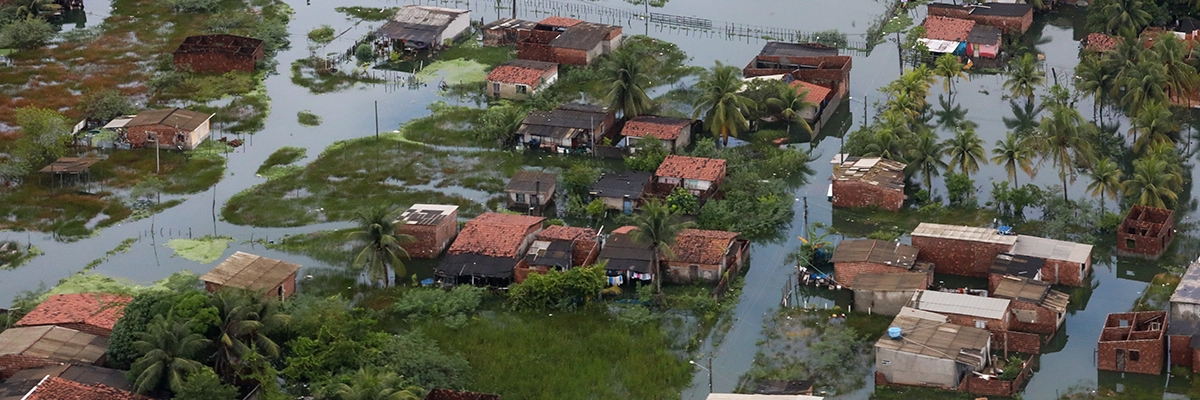In less than 24 hours on 27-28 of May, the Brazilian state Pernambuco received more than 70% of the rain that usually falls in all of May. This extreme accumulation followed a week of very heavy rainfall that began intensifying on 25 of May over several parts of Eastern Northeast Brazil including the states of Pernambuco, Sergipe, Alagoas, Rio Grande do Norte, and Paraíba, leading to landslides and widespread floods.
These events displaced at least 25,000 people and more than 133 people died. While the densely populated Metropolitan Region of Recife (RMR) in the state of Pernambuco was particularly badly hit, with impacts concentrated in low-income neighbourhoods on or near hillslopes, 80 municipalities across Pernambuco and Alagoas declared a state of emergency following the events. Eastern Northeast Brazil is also the region of the country with the highest proportion of the population living in poverty, making it particularly vulnerable to changing intensity and likelihoods of extreme weather events.
To analyse whether and to what extent human-caused climate change altered the likelihood and intensity of this extreme rainfall, scientists from Brazil, the Netherlands, France, the US and the UK used published, peer-reviewed methods to perform an event attribution study, focused on the amount of rain that fell over 7-day and 15-day periods, in an area of coastal tropical climate (10°S-5°S; 36°W-45.5°W) that encompasses the region of the extreme event of May 2022. While the heaviest rain fell over the sea, we limit our analysis to the land, as that is where impacts occur.

Main findings
- The flooding and landslides leading to severe impacts were a direct consequence of extremely heavy rainfall in the week beginning on 23 May and continuing into June. We therefore assess the role of climate change in 7 & 15-day mean rainfall.
- While the full profile of the impacts on human life and livelihoods has yet to be analysed, initial assessments show that the floods and particularly landslides disproportionately affected vulnerable communities, with particular devastation in low-income neighbourhoods . Thus, the magnitude of this disaster on these groups has been exacerbated by pre-existing structural vulnerability in the region.
- Today, there is a dense network of 389 weather stations in the area. However, we select 75 stations that have consistent data since at least the 1970s and are distributed across the study region for our observational analysis. Both the 7- and 15-day events are exceptionally rare events, which have only approximately a 1-in-500 and 1-in-1000 chance respectively of happening in any year in today’s climate, which has been warmed about 1.2°C by human activities.
- Although they are still very unusual, these events are now more likely to happen than they would have been in a climate that had not been warmed by human activities. But, as both events are far outside the previously observed records, it is not possible to quantify how much more likely climate change has made them to happen, based on observations. Warming of the planet has also increased the intensity of the rainfall: rainfall events as rare as these, that occurred in a 1.2°C cooler climate, would have been approximately a fifth less intense.
- To determine the role of climate change in these observed changes we undertake the same assessment using climate models. While many climate models are able to simulate the main precipitation features over the region, we find that for this spatially small event, all models exhibit systematic errors in precipitation magnitudes, partly due to having coarse spatial resolution and misrepresentation of key physical processes (e.g. convection). We can therefore not quantify the role of climate change in the observed increase in likelihood and intensity.
- However, combining observations with our physical understanding of the climate system we conclude that human-caused climate change is, at least in part, responsible for the observed increases in likelihood and intensity of heavy rainfall events as observed in May 2022.
- These findings are consistent with future projections of heavy rainfall in the region and suggest that these trends will continue to increase as long as greenhouse gas concentrations continue to increase. Also, due to climate change, other factors such as rising sea levels and higher tides could increase the vulnerability to heavy rainfall, leading to more urban floods in Recife, for example.
- The extreme nature of the floods made it so that exposure was the main determinant of impact, although long-term impacts and recovery will likely be mediated by socio-economic, demographic and governance factors. An increase in urbanisation, especially unplanned and informal in low-lying flood-prone areas and steep hillsides have increased the community exposure to these hazards. While forecasts and warnings were provided, it is unclear to what extent these informed anticipatory or early action that could have reduced the impacts.
- This indicates the need to review and strengthen the linkage between weather warnings and the process that would lead to anticipatory action based on those warnings. This region also generally has an infrastructure deficit (e.g. housing, roads, water and sanitation etc.). As new infrastructure is built, there is an opportunity to increase resilience by accounting for increasing risks in the design and location, instead of reverting to outdated design standards.





